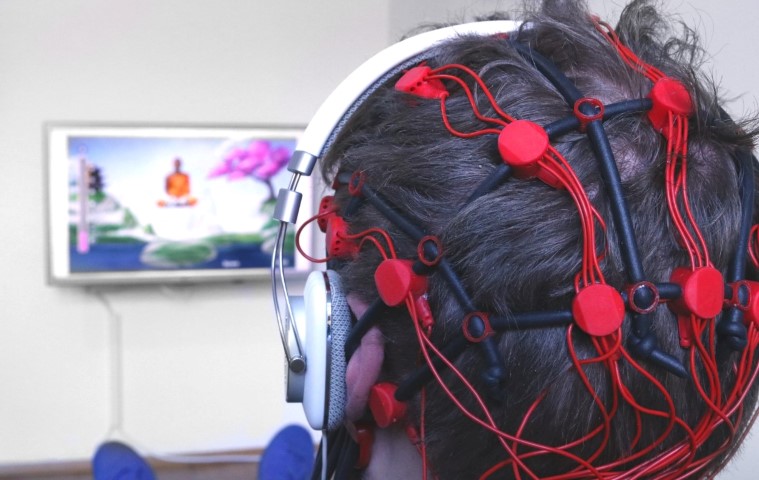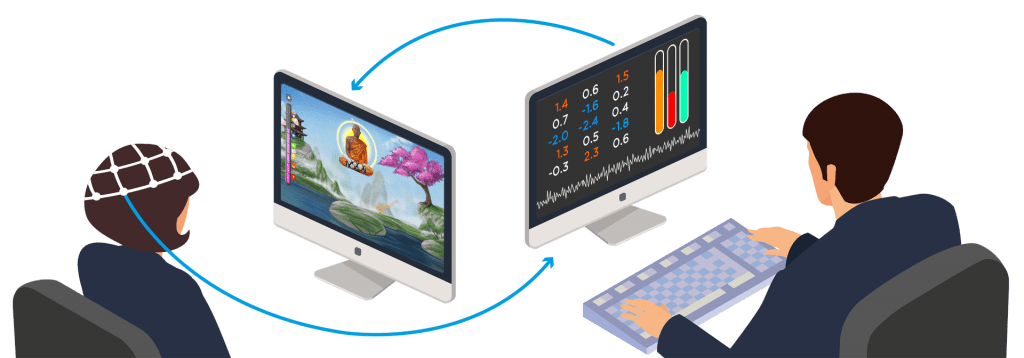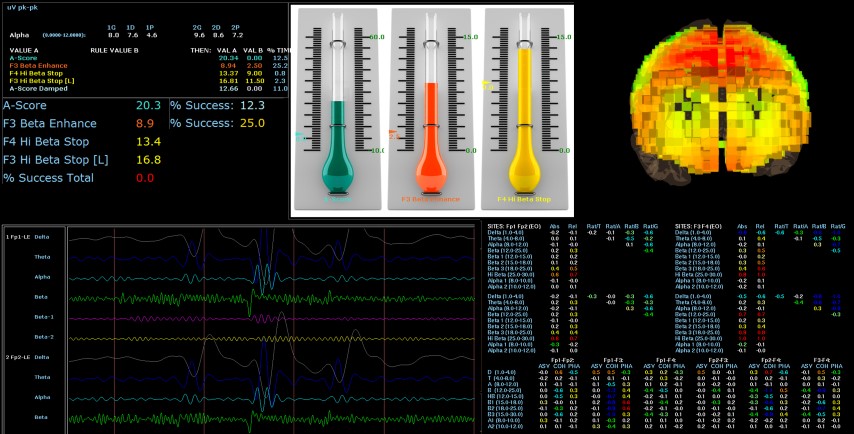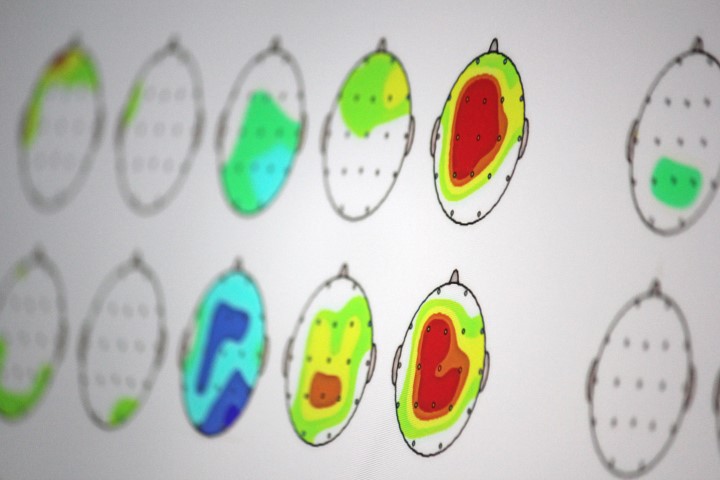
Neurofeedback - this is how it works
50 min. per training
1 - 2 sessions per week
sustainable effects starting at approx. 10 sessions
individual training protocols
1) The anamnesis - the quantitative EEG
An qEEG (quantitative EEG), or also called brainmapping, is the analysis of a 19-channel EEG. It records the “current activity” of the brain.
This measurement process is completely pain-free for the client. The exact analysis of the raw EEG provides a fast and economic visualization of the brain activity which delivers valuable information for the subsequent training.
Functional limitations of the brain, such as after a concussion or a variety of mental illnesses, can be demonstrated with a qEEG objectively.
An qEEG (quantitative EEG), or also called brainmapping, is the analysis of a 19-channel EEG. It records the “current activity” of the brain.
This measurement process is completely pain-free for the patient. The exact analysis of the raw EEG provides a fast and economic visualization of the brain activity which delivers valuable information for the subsequent training.
Functional limitations of the brain, such as after a concussion or a variety of mental illnesses, can be demonstrated with a qEEG objectively.
The qEEG is always at the beginning of a neurofeedback training. The aim is to guarantee an individual and optimal planning of the training. A graphical evaluation in the form of so-called “heatmaps” is created for each client.
From the vast amounts of scientific publications it is well known which brain activity patterns are desired according to the specific targeted mental states. Such patterns are efficiently supported and nurtured by the training.
In addition to the recording of the quantitative EEG, the first conversation with the client at the Heiler practice is a detailed medical anamnesis. Neurofeedback-trainer and client work together on the medical history, the current condition and the training goals.
The qEEG is always at the beginning of a neurofeedback therapy. The aim is to guarantee an individual and optimal planning of the therapy. A graphical evaluation in the form of so-called “heatmaps” is created for each patient.
From the vast amounts of scientific publications it is well known which brain activity patterns are desired according to the specific targeted mental states. Such patterns are efficiently supported and nurtured by the training.
In addition to the recording of the quantitative EEG, the first conversation with the patient in the Heiler practice is a detailed medical anamnesis. Doctor and patient work together on the medical history, the current condition and the training goals.
2) Neurofeedback-Training
EEG Analysis in real time
In neurofeedback training, measuring electrodes, connected to a pleasant cap, are first attached to the head at fixed points. By measuring brain activity, the neurofeedback-trainer derives an EEG (electroencephalogram). The client himself does not feel anything from the EEG recording. The EEG measures all relevant brain waves and forwards them to a computer. A special computer program divides the brain waves into frequency ranges and subjects them to analysis. All important data are measured in real time (with only 30 milliseconds delay) and 50 times per second.
In neurofeedback training, measuring electrodes, connected to a pleasant cap, are first attached to the head at fixed points. By measuring brain activity, the doctor derives an EEG (electroencephalogram). The patient himself does not feel anything from the EEG recording. The EEG measures all relevant brain waves and forwards them to a computer. A special computer program divides the brain waves into frequency ranges and subjects them to analysis. All important data are measured in real time (with only 30 milliseconds delay) and 50 times per second.
Feedback-Training
The data analysis described above is to be conveyed to the client in the following simple form as feedback , there are many different possibilities. These include virtual reality environments, movies, music/sounds, games (often interesting for children to maintain motivation during training) and many other options.
The feedback is based on the principle of so-called operant conditioning. This means that the feedback given to the client represents a reward if the client succeeds in activating certain brain areas in such a way that they generate the desired brain activity. In concrete terms, the reward means, for example, that the film appears bright and clearly visible. The “punishment” shows a dark and badly visible film. These processes work also with music. It is either loud and well audible or quiet and almost incomprehensible.
Our brain wants to be rewarded as often as possible. It constantly tries to recognize and understand the patterns hidden in the feedback in order to receive a reward as often as possible. This process takes place completely unconsciously, without the active intervention of the client and without medication.
The data analysis described above is to be conveyed to the patient in the following simple form as feedback , there are many different possibilities. These include virtual reality environments, movies, music/sounds, games (often interesting for children to maintain motivation during training) and many other options.
The feedback is based on the principle of so-called operant conditioning. This means that the feedback given to the patient represents a reward if the patient succeeds in activating certain brain areas in such a way that they generate the desired brain activity. In concrete terms, the reward means, for example, that the film appears bright and clearly visible. The “punishment” shows a dark and badly visible film. These processes work also with music. It is either loud and well audible or quiet and almost incomprehensible.
Our brain wants to be rewarded as often as possible. It constantly tries to recognize and understand the patterns hidden in the feedback in order to receive a reward as often as possible. This process takes place completely unconsciously, without the active intervention of the patient and without medication.
On our Youtube channel you will find further interesting knowledge videos
On our Youtube channel you will find more interesting knowledge videos
Possibilities for feedback
We at brainboost develop almost all feedback variations ourselves – this is the only way we can offer you a unique neurofeedback
Virtual Reality Neurofeedback
We combine the immersive Virtual Reality technology with our Neurofeedback Training in order to realistically represent as many individual training situations as possible. Virtual Reality enables the seamless transition between reality and the virtual world and offers us the possibility to put our customers in the middle of another world, which puts a training room in the shade within a few seconds and enables real experiences. Never before has neurofeedback training been so exciting.
We combine the immersive Virtual Reality technology with our Neurofeedback Training in order to realistically represent as many individual training situations as possible. Virtual Reality enables the seamless transition between reality and the virtual world and offers us the possibility to put our customers in the middle of another world, which puts a treatment room in the shade within a few seconds and enables real experiences. Never before has neurofeedback therapy been so exciting.
Neurofeedback with Audio & Video

Neurofeedback Training with audio & video as feedback medium is very well accepted by adults and children. The trainee watches a film or listens to music of his choice. The feedback itself is controlled by the brightness and size of the screen and the volume of the music.
For example, you can train with your favorite music or TV series.
Neurofeedback Training with audio & video as feedback medium is very well accepted by adults and children. The trainee watches a film or listens to music of his choice. The feedback itself is controlled by the brightness and size of the screen and the volume of the music.
For example, you can train with your favorite music or TV series.
Neurofeedback Soundexperience
(in development)
In cooperation with Devialet and VR toning – two leading companies in their field – we are developing a revolutionary training form of neurofeedback.
With Neurofeedback Soundexperience we combine neurofeedback training with audio feedback of a special kind.
Professional sound designers of VR toning create a moving audio experience that leads you into different sound worlds during the training.
In order to perceive the experience in its full sound spectrum, we rely on the high-quality Premium Speakers of the French brand Devialet.
In cooperation with Devialet and VR toning – two leading companies in their field – we are developing a revolutionary training form of neurofeedback.
With Neurofeedback Soundexperience we combine neurofeedback training with audio feedback of a special kind.
Professional sound designers of VR toning create a moving audio experience that leads you into different sound worlds during the training.
In order to perceive the experience in its full sound spectrum, we rely on the high-quality Premium Speakers of the French brand Devialet.
Neurofeedback Games

Especially with children it is important to keep the motivation for neurofeedback training high. In our experience this works best with games as feedback medium. We have developed a variety of neurofeedback games together with our partner brainboost Neurofeedback . Especially our patients with attention problems or ADHD perceive this kind of feedback as very beneficial.
A selection of our most popular neurofeedback games can be found further down on this page.
Popular Neurofeedback Games
A small selection of our self-developed Neurofeedback Games
On our channels you will find further interesting knowledge videos & games









